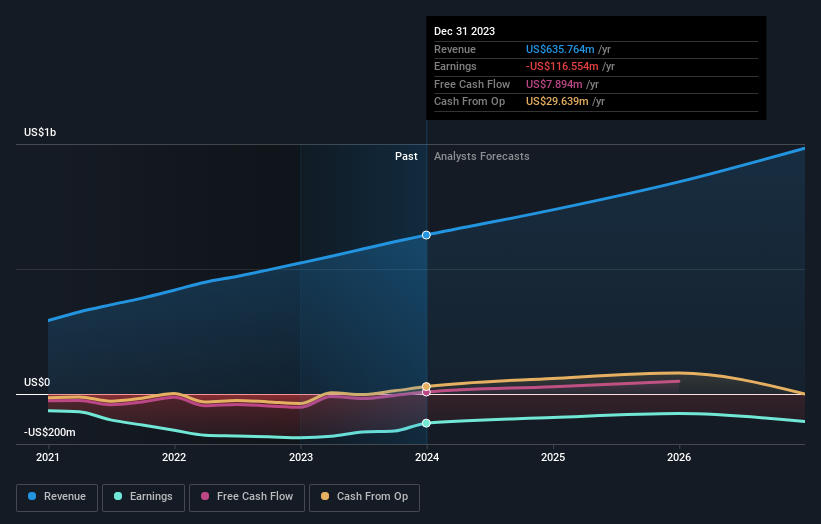Coursera, Inc. (NYSE:COUR), might not be a large cap stock, but it saw significant share price movement during recent months on the NYSE, rising to highs of US$20.66 and falling to the lows of US$13.95. Some share price movements can give investors a better opportunity to enter into the stock, and potentially buy at a lower price. A question to answer is whether Coursera's current trading price of US$13.95 reflective of the actual value of the mid-cap? Or is it currently undervalued, providing us with the opportunity to buy? Let’s take a look at Coursera’s outlook and value based on the most recent financial data to see if there are any catalysts for a price change.
View our latest analysis for Coursera
What Is Coursera Worth?
Good news, investors! Coursera is still a bargain right now. Our valuation model shows that the intrinsic value for the stock is $17.94, which is above what the market is valuing the company at the moment. This indicates a potential opportunity to buy low. However, given that Coursera’s share is fairly volatile (i.e. its price movements are magnified relative to the rest of the market) this could mean the price can sink lower, giving us another chance to buy in the future. This is based on its high beta, which is a good indicator for share price volatility.
What kind of growth will Coursera generate?

Investors looking for growth in their portfolio may want to consider the prospects of a company before buying its shares. Buying a great company with a robust outlook at a cheap price is always a good investment, so let’s also take a look at the company's future expectations. However, with a relatively muted profit growth of 5.7% expected over the next couple of years, growth doesn’t seem like a key driver for a buy decision for Coursera, at least in the short term.
What This Means For You
Are you a shareholder? Even though growth is relatively muted, since COUR is currently undervalued, it may be a great time to accumulate more of your holdings in the stock. However, there are also other factors such as capital structure to consider, which could explain the current undervaluation.
Are you a potential investor? If you’ve been keeping an eye on COUR for a while, now might be the time to make a leap. Its future outlook isn’t fully reflected in the current share price yet, which means it’s not too late to buy COUR. But before you make any investment decisions, consider other factors such as the strength of its balance sheet, in order to make a well-informed investment decision.
So while earnings quality is important, it's equally important to consider the risks facing Coursera at this point in time. Case in point: We've spotted 2 warning signs for Coursera you should be aware of.
If you are no longer interested in Coursera, you can use our free platform to see our list of over 50 other stocks with a high growth potential.
New: AI Stock Screener & Alerts
Our new AI Stock Screener scans the market every day to uncover opportunities.
• Dividend Powerhouses (3%+ Yield)
• Undervalued Small Caps with Insider Buying
• High growth Tech and AI Companies
Or build your own from over 50 metrics.
Have feedback on this article? Concerned about the content? Get in touch with us directly. Alternatively, email editorial-team (at) simplywallst.com.
This article by Simply Wall St is general in nature. We provide commentary based on historical data and analyst forecasts only using an unbiased methodology and our articles are not intended to be financial advice. It does not constitute a recommendation to buy or sell any stock, and does not take account of your objectives, or your financial situation. We aim to bring you long-term focused analysis driven by fundamental data. Note that our analysis may not factor in the latest price-sensitive company announcements or qualitative material. Simply Wall St has no position in any stocks mentioned.
About NYSE:COUR
Coursera
Provides online educational services in the United States, Europe, Africa, the Asia Pacific, the Middle East, and internationally.
Flawless balance sheet and fair value.
Similar Companies
Market Insights
Weekly Picks


Crazy Undervalued 42 Baggers Silver Play (Active & Running Mine)


Fiducian: Compliance Clouds or Value Opportunity?

Willamette Valley Vineyards (WVVI): Not-So-Great Value
Recently Updated Narratives

Moderation and Stabilisation: HOLD: Fair Price based on a 4-year Cycle is $12.08


Positioned globally, partnered locally


When will fraudsters be investigated in depth. Fraud was ongoing in France too.
Popular Narratives


MicroVision will explode future revenue by 380.37% with a vision towards success


NVDA: Expanding AI Demand Will Drive Major Data Center Investments Through 2026





